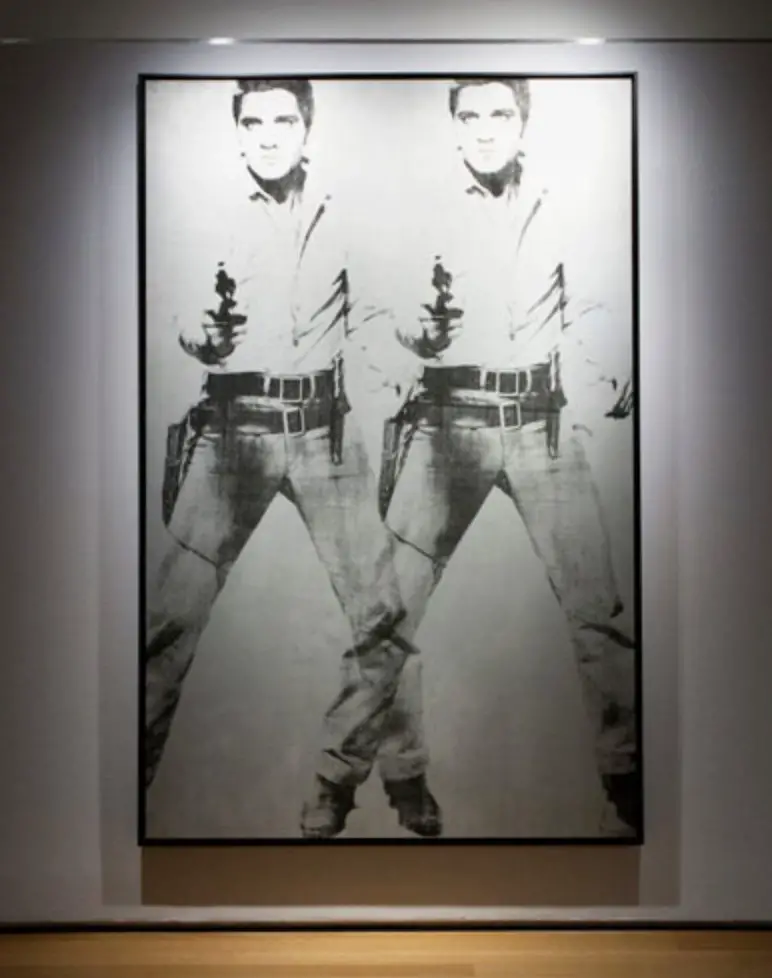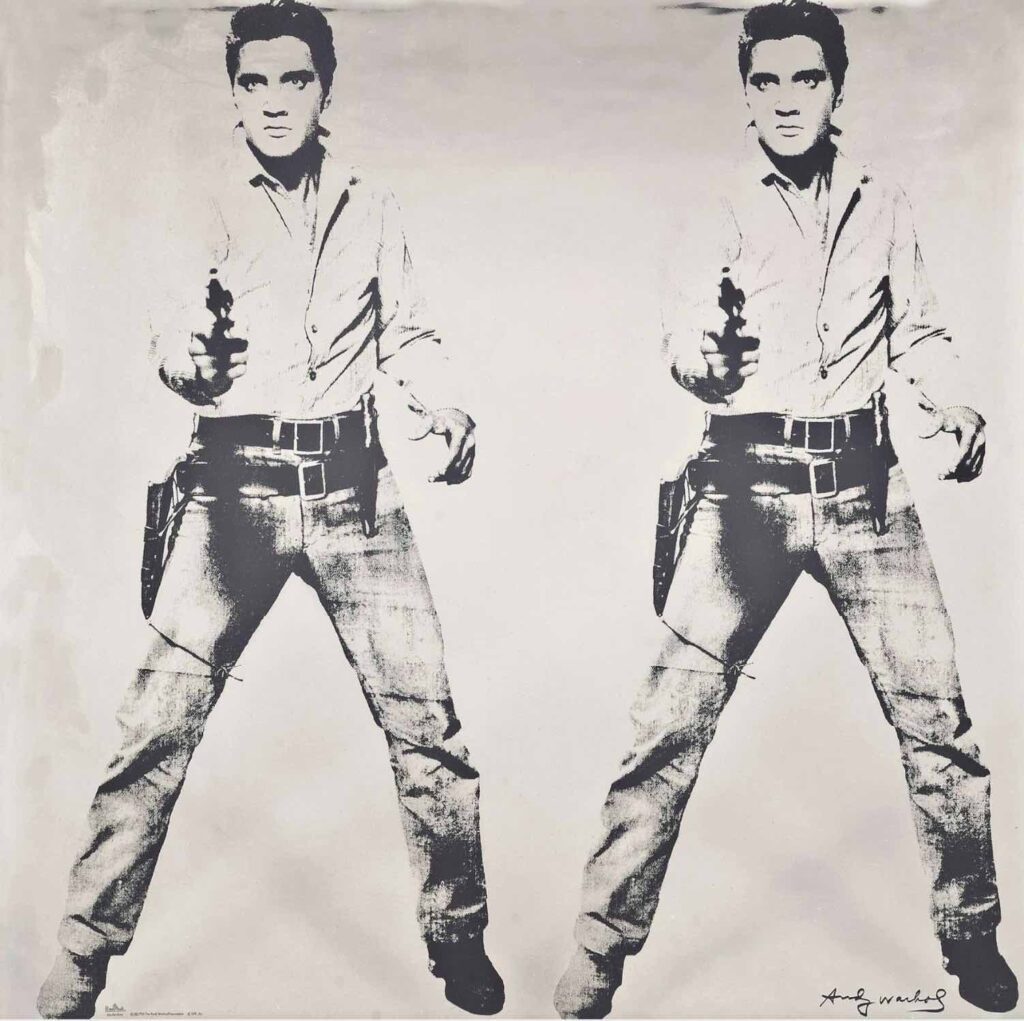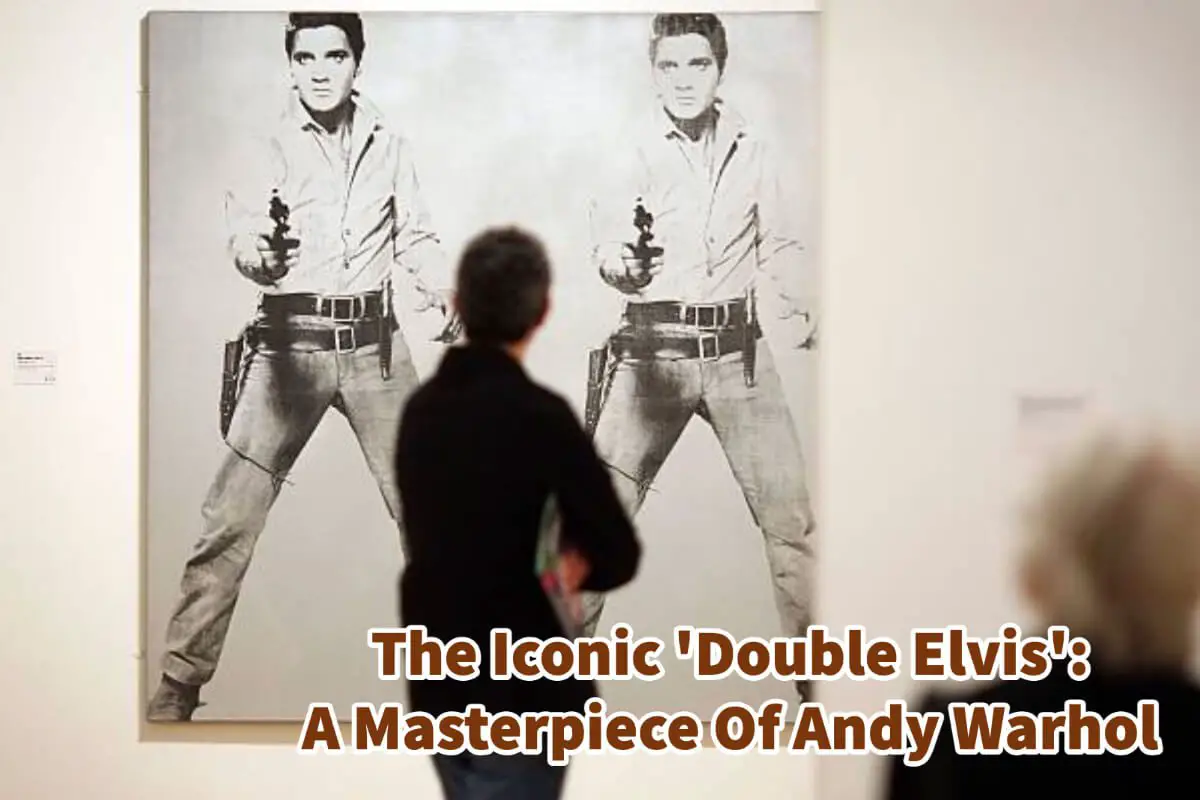In the luminous art world, where vivid imaginations converge with expressive brilliance, specific names reverberate through history with an unwavering resonance. Andy Warhol, a titan of 20th-century art, is undeniably one such figure. With an artistic vision that masterfully blurred the lines between traditional art and popular culture, Warhol’s works have continued to engage, intrigue, and provoke long after his demise.
Among the artist’s extensive body of work, one particular masterpiece stands out due to its multi-layered connotations and iconic visual appeal – the mesmerizing “Double Elvis” created in 1963. The allure of “Double Elvis,” one of Warhol’s most iconic works, explores the myriad reasons behind its celebrated status in art. In this iconic artwork, Elvis Presley’s image takes center stage, reflecting the overlapping nuances of fame, performance, and identity in mid-20th-century America.
Table of Contents
- The Iconic ‘Double Elvis’: A Masterpiece Of Andy Warhol Explored
- 15 Reasons Why The Double Elvis By Andy Warhol Is Inonic
- Pop Art Pioneer
- Commentary On Celebrity Culture
- Silkscreen Technique
- Reflection Of American Culture:
- Unsettling Aesthetics
- Fascination With Death
- Repetition And Multiplicity
- Fusion Of High And Low Art
- Challenge To Traditional Portraiture
- Visual Impact
- The Interplay Of Presence And Absence
- Cultural Resonance
- Warhol’s Obsession
- Public Reaction
- Price At Auction
- Frequently Asked Questions
- Related Questions
The Iconic ‘Double Elvis’: A Masterpiece Of Andy Warhol Explored
As we dive into the world of modern art, we often come across names that have shaped and revolutionized the sphere. Andy Warhol is one such name, an artist who made an indelible mark in the field with his pioneering artwork.
Among his extensive repertoire, one artwork stands apart due to its cultural resonance and startling commentary on fame and celebrity culture – the “Double Elvis,” painted in 1963.

In “Double Elvis,” Warhol presents us with a hauntingly desolate and mesmerizing image of Elvis Presley, one of the most iconic figures of the time. This artwork is a nexus of Warhol’s fascination with celebrity, pop culture, and the innate artificiality that underscores them.
15 Reasons Why The Double Elvis By Andy Warhol Is Inonic
When Andy Warhol unveiled the remarkable “Double Elvis,” he had already established his reign as the king of Pop Art in New York City. Hence, it seemed only apt that he would choose to portray another significant cultural figure, such as Elvis Presley, to illustrate his artistic perspective.

So, why is “Double Elvis” hailed as an iconic work of art? Here are 15 reasons:
Pop Art Pioneer
“Double Elvis” solidified Warhol’s position as a pioneer in the pop art movement. The image of a celebrity taken from mass-produced publicity still, combined with Warhol’s signature silkscreen technique, encapsulates the ethos of pop art.
Commentary On Celebrity Culture
“Double Elvis” profoundly reflects the celebrity culture that marked the 1960s. By repeating Presley’s image, Warhol amplifies the concept of fame and its implications on individual identity.
Silkscreen Technique
This artwork is a classic example of Warhol’s innovative use of the silkscreen technique, which enabled him to achieve his desired mass-produced effect, reflecting the industrial nature of modern society.
Reflection Of American Culture:
The piece reflects the fascination with cowboy culture and Hollywood westerns that dominated mid-20th-century America. Elvis, dressed as a gunslinger, encapsulates this popular American myth.
Unsettling Aesthetics
The artwork’s aesthetics are alluring and unsettling, a dualism that characterizes many of Warhol’s pieces. This makes the painting engaging, forcing viewers to contemplate its deeper meanings.
Fascination With Death
“Double Elvis” also subtly touches upon Warhol’s fascination with death, evident from the image of Elvis as a gunslinger ready to shoot – a ghostly specter reminiscent of the mortality that fame cannot elude.
Repetition And Multiplicity
The repeated image in “Double Elvis” amplifies Warhol’s exploration of mass production and replication, commenting on the manufactured nature of celebrity and fame.

Fusion Of High And Low Art
Warhol seamlessly blends high (fine art) and low (popular culture) art elements, breaking traditional boundaries and offering a new perspective on art consumption and appreciation.
Challenge To Traditional Portraiture
The piece challenges traditional concepts of portraiture by presenting a famous figure not in a regal or formal pose but in a theatrical and potentially violent stance.
Visual Impact
The stark contrast between the black-and-silver Elvis and the silver background, along with the deliberate blurring, creates a striking visual impact, making the work unforgettable.
The Interplay Of Presence And Absence
Warhol’s use of negative space and the faint second image of Elvis creates an intriguing interplay of presence and absence, hinting at the transient nature of fame.
Cultural Resonance
“Double Elvis” was created at the height of the artist’s career, when both Elvis and Warhol were significant cultural figures. The painting, thus, holds excellent cultural and historical significance.
Warhol’s Obsession
The artwork represents Warhol’s obsession with fame and identification with the stars he painted, making it a profoundly personal work.
Public Reaction
The public’s reaction to “Double Elvis,” both initially and over time, underscores its importance. Despite a lukewarm initial reception, it has become one of Warhol’s most renowned works.
Price At Auction
The high price that “Double Elvis” fetches at auctions today (one version was sold for over $37 million in 2012 and in 2014 for $81.9 million) indicates its iconic status and enduring appeal in the global art market.
Andy Warhol’s “Double Elvis” is an iconic work of art for multiple reasons, ranging from its groundbreaking technique to its poignant commentary on celebrity culture and the American Dream.
The artwork engages audiences worldwide, offering insights into Warhol’s genius and discerning perspective on fame, mortality, and the human condition.
Anita Louise Art is dedicated to art education, great artists, and inspiring others to find and create their art. We love art that uplifts and inspires. #ArtToMakeYouSmile! #ArtToMakeYouHappy!
If you want to see any of my art, you can find out more by clicking here. If you are interested in what inspires me and my paintings, you can discover more by clicking here.
We have a free newsletter and would love you to be part of our community; you can subscribe to the newsletter by clicking here. If you have any questions, I would be happy to talk to you. You can reach me, Anita, by clicking here.
Subscribe to our Anita Louise Art YouTube Channel, filled with great videos and information, by clicking here.
Join us for our podcast “5 Minutes With Art.” Spend 5 minutes a week with us to discover and learn about great art and artists. You can find out more about our podcast by clicking here.
Frequently Asked Questions
What is the significance of Andy Warhol’s “Double Elvis” in the art world?
“Double Elvis” is considered significant for its masterful blending of traditional art and popular culture, reflecting Warhol’s unique artistic vision. It stands out as an iconic representation of fame and identity in mid-20th-century America.
How did Andy Warhol create “Double Elvis,” and what techniques did he employ?
Warhol created “Double Elvis” in 1963 using his signature silkscreen printing technique. He often employed this method to produce multiple copies of an image, blurring the lines between mass production and individual expression.
Why did Andy Warhol choose Elvis Presley as the subject of this masterpiece?
Elvis Presley was a cultural icon of the time, embodying themes of fame and performance. Warhol was drawn to Presley’s celebrity status and used his image to explore the complexities of fame and identity in American society.
What is the meaning behind the title “Double Elvis”?
The title “Double Elvis” refers to the repetition of Elvis Presley’s image in the artwork. The doubling effect adds depth to the exploration of identity and fame, suggesting a complex and multifaceted understanding of the iconic figure.
How does “Double Elvis” reflect Warhol’s fascination with celebrity culture?
Warhol’s fascination with celebrity culture is evident in “Double Elvis” through the repeated image of the iconic pop culture figure. The artwork highlights Warhol’s interest in the commodification and repetition of celebrity imagery.
What reactions did “Double Elvis” elicit when it was first introduced to the public?
“Double Elvis” generated mixed reactions upon its introduction. Some admired its boldness and commentary on fame, while others questioned the artistic merit of using popular culture icons in fine art.
Are there any hidden or symbolic elements in “Double Elvis” that viewers may overlook?
While the artwork is visually striking, Warhol’s use of repetition and the choice of Elvis Presley may hold deeper symbolic meanings related to the mass media’s influence on identity and the construction of fame.
How has “Double Elvis” influenced subsequent generations of artists and pop culture?
“Double Elvis” has served as a source of inspiration for artists exploring the intersection of art and popular culture. Its impact can be seen in contemporary art that continues to engage with celebrity imagery and the commodification of fame.
Is “Double Elvis” considered a commentary on the changing landscape of American society in the 1960s?
Yes, “Double Elvis” is often interpreted as a commentary on the evolving nature of American society during the 1960s. It captures the shifting dynamics of fame, performance, and identity in the midst of cultural changes.
Where is the original “Double Elvis” located, and has it ever been part of notable exhibitions or collections?
The original “Double Elvis” is part of various prestigious art collections. It has been exhibited globally, including at major retrospectives of Andy Warhol’s work, making it a celebrated piece in the art world.
Related Questions
What Was The Focus Of Renaissance Art?
Renaissance art focused on the classics of Greek and Rome, humanist philosophy, and the study of the human figure. Realism was also an essential part of renaissance art. The great artists of the Renaissance also became great anatomists and studied human beings.
By clicking here, you can learn more by reading What Was The Focus Of Renaissance Art?.
What Is The Importance Of Art From The Renaissance Period?
Renaissance art is essential as it was a time of rebirth and discovery. Artists like Leonardo da Vinci, Michelangelo, and Raphael were at the forefront of that change, creation, and discovery. Renaissance art has influenced art and artists for many centuries and continues to influence artists today.
By clicking here, you can learn more by reading What Is The Importance Of Art From The Renaissance Period?.
21 Top Renaissance Artists And Their Works Of Art
When we speak of top Renaissance artists, we think of the trinity of artists like Leonardo da Vinci, Michelangelo, and Raphael. But besides these three artists, many other influential Renaissance artists remain essential.
By clicking here, you can learn more by reading 21 Top Renaissance Artists And Their Works of Art.

